10 Best Ground Cover Plants For Florida
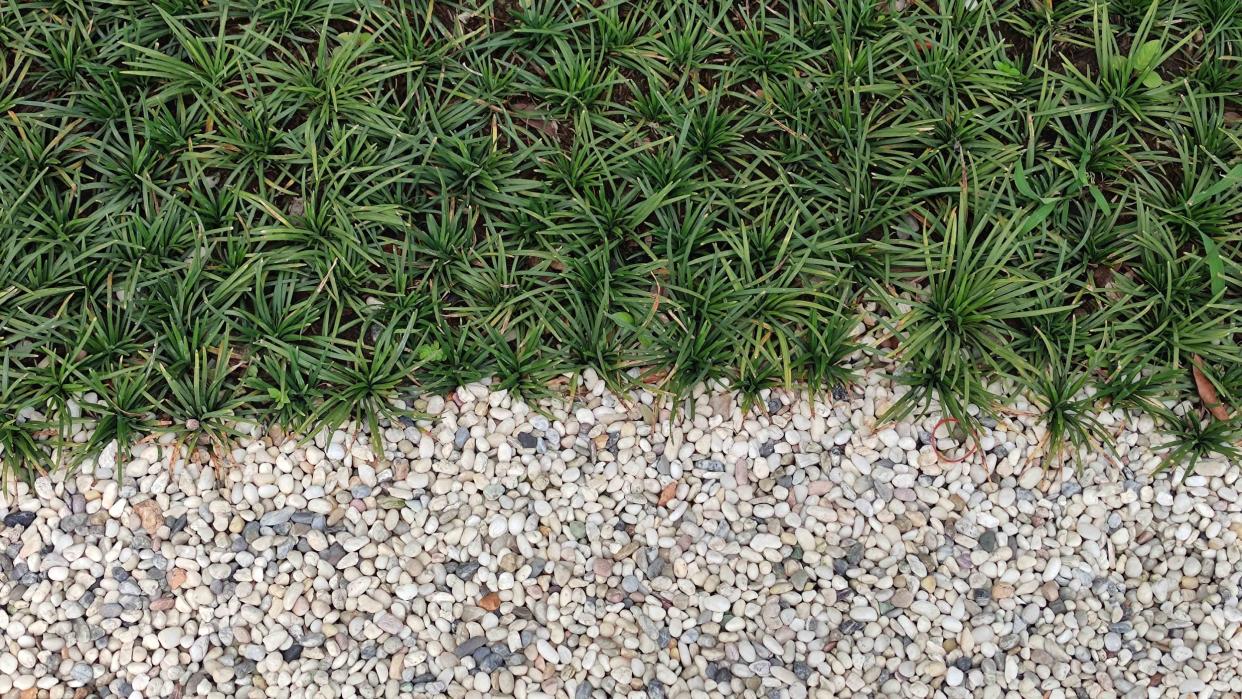
Getty Images
Ground covers are the problem solvers of the plant world. They can do everything from preventing erosion on slopes to filling in areas where grass won’t grow to providing food for pollinators. “Many ground covers are low-maintenance compared to grass, which requires mowing, irrigation, fertilizer and pest control,” says Tia Silvasy, residential horticulture agent with the University of Florida Extension, Institute of Food and Agricultural Sciences. “Some ground covers are as close to do-nothing landscaping as you can get.”
What To Consider When Choosing a Ground Cover
Before choosing a type of ground cover, pay attention to the conditions in your yard. “There’s a plant to match every site, but you need to know how much sun an area gets,” says Silvasy. Next, you’ll also need to do some ground prep, including removing every last weed, raking up the area, and adding about 1/2 inch of compost to amend the soil.
Remember that, for creeping plants which form a dense mat, the closer together you plant them, the faster they’ll fill in the area. Silvasy generally recommends no farther apart than six inches. Once you’ve planted, keep the area weed-free, and water your plantings until they get established, which takes a few months.
Ahead, 10 of our favorite Florida ground cover plants:
Perennial Peanut
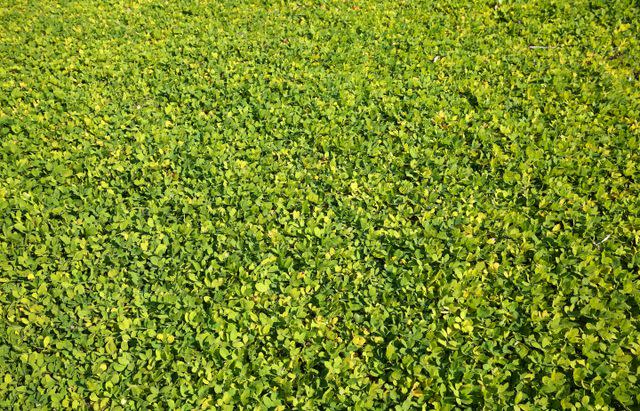
Getty Images
“This is a tried-and-true ground cover,” says Silvasy. “It’s a nitrogen fixer so you won’t have to fertilize, and it can take various conditions.” The tiny yellow flowers, which appear in spring, are even edible. Perennial peanut is evergreen in frost-free areas but otherwise goes dormant in winter. It tolerates full sun to part shade.
Botanical Name: Arachis glabrata
Sun Exposure: Full, Partial
Asiatic Jasmine

Getty Images
Asiatic jasmine is a good choice in shady areas, such as under a big oak tree where nothing else grows. It’s not ideal for heavy foot traffic, though, so plant it where it won’t get trampled. It’s a hardy evergreen plant which doesn’t die back in winter, and it can take both full shade and full sun.
Botanical Name: Trachelospermum asiaticum
Sun Exposure: Full, Shade
Powderpuff Mimosa

Getty Images
Powderpuff mimosa, also known as sunshine mimosa, is a low-growing plant that spreads rapidly. It can be used as turf replacement and can be mowed and walked on. It’s not evergreen, but it is slightly aggressive, so make sure it’s edged with a natural boundary, such as a sidewalk. It also gets adorable pink powderpuff flowers from spring to fall and is a butterfly larvae host plant. It tolerates full sun to part shade.
Botanical Name: Mimosa strigillosa
Sun Exposure: Full, Partial
Frogfruit
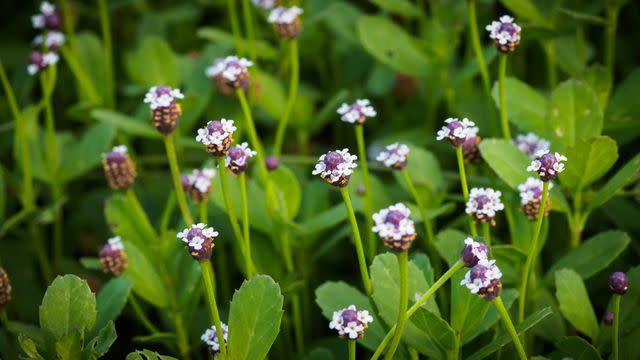
Getty Images
Frogfruit, a native Florida ground cover with a whimsical name, is a host plant to three different types of butterflies, says Silvasy. You can mow it and walk on it, and it’s drought and flood tolerant. The tiny purple flowers bloom year-round and attract pollinators. Plant it in full sun to part shade.
Botanical Name: Phyla nodiflora
Sun Exposure: Full, Partial
Dwarf Mondo Grass
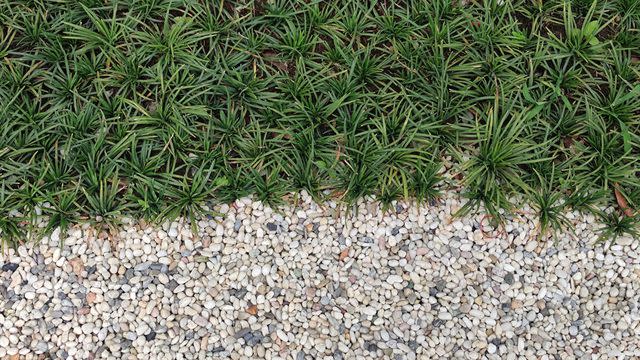
Getty Images
Dwarf mondo grass grows in clumps with 4 to 6-inch-tall tufts, which give the appearance of a lawn when planted in groupings. Some other varieties reach up to two feet tall. It’s often confused with liriope, which is considered invasive in some parts of the state and no longer recommended. Mondo grass is evergreen, and it tolerates both sun and shade.
Botanical Name: Ophiopogon japonicus
Sun Exposure: Full, Shade
Periwinkle

Getty Images
This fast-growing evergreen groundcover is more cold-tolerant than many other Florida groundcovers, says Silvasy. Periwinkle has purple, blue or white flowers, which bloom in spring and sporadically in summer and fall. It takes full sun to full shade.
Botanical Name: Vinca major
Sun Exposure: Full, Shade
Holly Fern
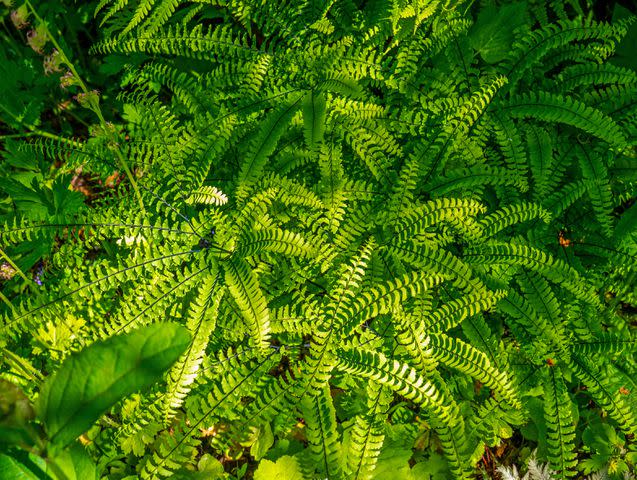
Getty Images
Holly fern has tons of ornamental appeal with its large, glossy 2 to 3-foot-tall fronds appear in clumps. It stays green all year in frost-free areas and requires almost no maintenance. It needs part to full shade.
Botanical Name: Cyrtomium falcatum
Sun Exposure: Partial, Shade
Shore Juniper
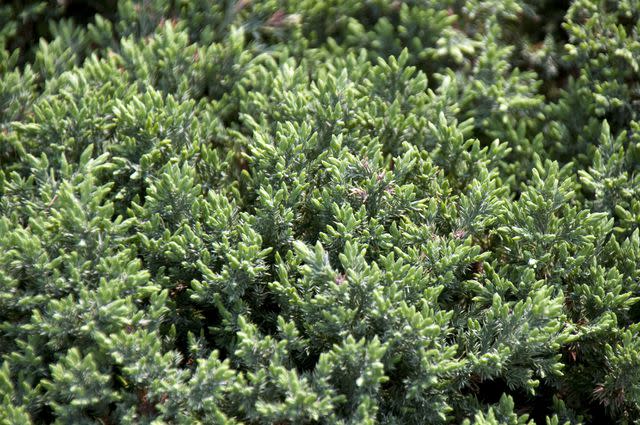
Getty Images
If you’re looking for an evergreen shrub to use as a groundcover, shore juniper has a low-growing habit that reaches one to two feet tall. It’s slow-growing but drought-tolerant once established, and it needs full sun.
Botanical Name: Juniperus conferta
Sun Exposure: Full
Muhly Grass

Getty Images
Clusters of pink plumes in the fall make muhly grass an eye-catching perennial. It’s ideal in difficult spots, such as around the mailbox or when planted as clumps for erosion control, says Silvasy. Cut it back once a year in late winter to early spring before new growth appears. It can reach three to four feet tall and likes full sun.
Botanical Name: Muhlenbergia capillaris
Sun Exposure: Full
Beach Sunflower

Getty Images
Beach sunflower is a Florida native that butterflies love. It’s ideal for hot, dry sites, including coastal areas. It tends to reseed, forming larger clumps over time. Of course, it’s a sun lover, and like all sunflowers, the attractive little flower heads follow the path of the sun throughout the day.
Botanical Name: Helianthus debilis
Sun Exposure: Full
For more Southern Living news, make sure to sign up for our newsletter!
Read the original article on Southern Living.

